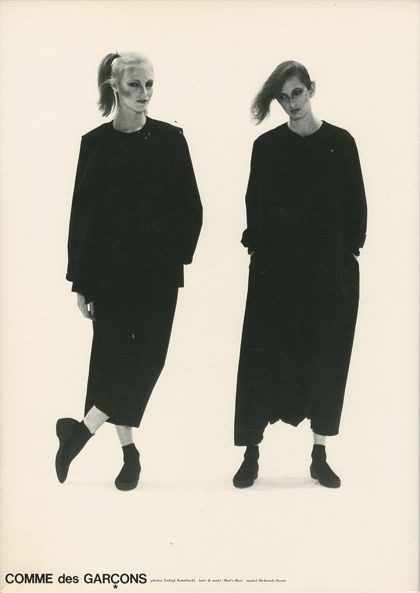This picture was tooken in 1977, Vivienne Westwood with other punk girls on a London street.
Vivienne Westwood is often cited as the Mother of Punk fashion, who often contribute to an aesthetic that brings a subcultural style to the mainstream fashion.
The ripped garments, the leather, chains and badges of the bikers; the straps and buckles of the fetishists are often found in Westwood’s designs. As Westwood said, ‘You couldn’t imagine the Punk Rock thing without the clothing’. The punk look has been always illustrated with clothing that has been destroyed, then put back together, whish somtimes are inside out, or unfinished, it was an early manifestation of deconstructionist fashion, which is an important plot of late twentieth-century postmodern style that has been developed to be seen in the work of contemporary fashion designers such as Rei Kawakubo and Martin Margiela.
This is the campaign photo of two blended wool coats and integrated bags, from Yohji Yamamoto A/W 1983 collection. The two models in the image were not gender specific, wearing loose fitted coat, with deconstructed seams.
“When I started designing, I wanted to make men’s clothes for women” Yamamoto said in an interview. We can often see this philosophy presented in his designs, Yamamoto refused to accept traditional ideas of female sexual display, and reacts against the Western notion of feminity expressed in figure-hugging silhouettes. Yamamoto’s designs are known of well used of methods of layering, draping, and wrapping the body, dressed it with sombre, unstructured, swathed garments based on the kimono pattern, that take away the usual accentuation points. Fabrics often play a significant role in every Yamamoto piece. Exceptionally heavy fabrics and textiles can be often found in his pieces, which are not generally seen in womenswear.
Comme des Garçons, which was found by Rei Kawakubo, is known for its attitude in anti-fashion, and garments deconstruction. During the 1980s, her garments were primarily in black, dark grey or white. The materials were often draped around the body and featured frayed, unfinished edges along with holes and a general asymmetrical shape. Challenging the established notions of beauty she created an uproar at her debut Paris fashion show where journalists labeled her clothes ‘Hiroshima chic’ amongst other things.
During the 1980s, Rei Kawakubo was entitled as one of the the Japanese avantgardists, had created a new fashion scene with her unconventional and ground-breaking designs. Her designs were labeled as ‘Hirishima chic’ after her debut Paris fashion show, which challenged the established notions of beauty in the 80s. Her collection was seen as revolting against the luxurious fashion world with garments of oversized proportions, and garments draped around the body and featured frayed, unfinished hems along with holes, and asymmetrical silhouettes with lining, seams and hems outside on the garments.




